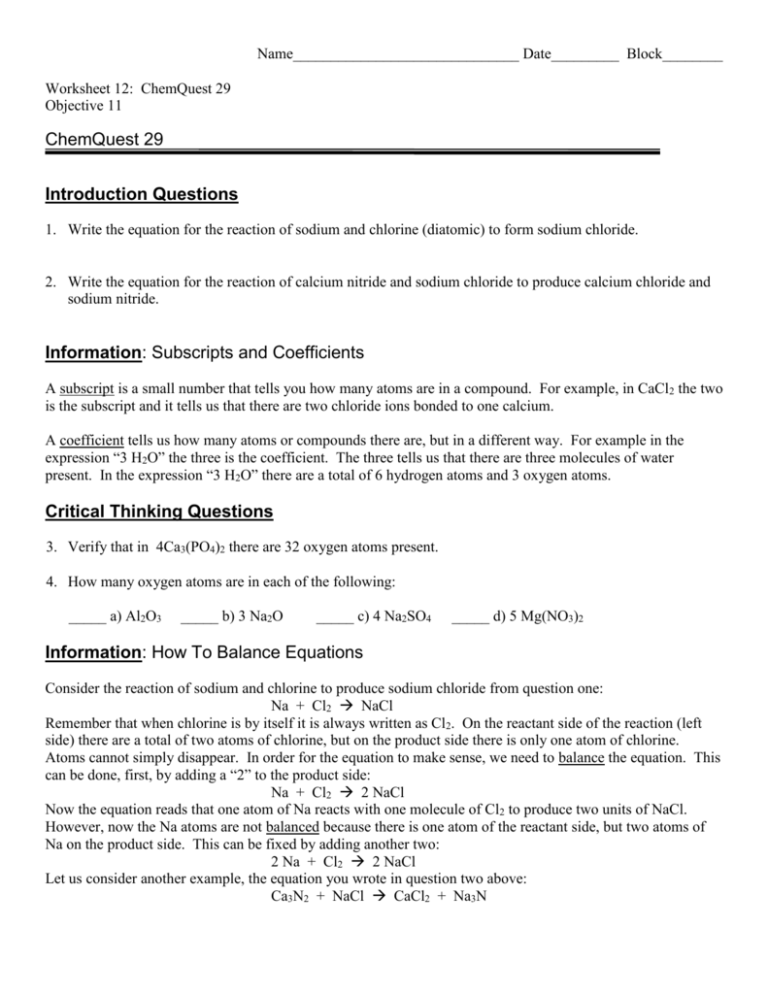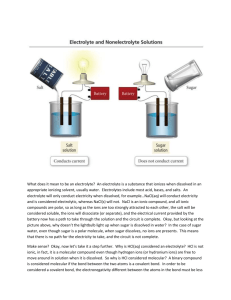Information
advertisement

Name______________________________ Date_________ Block________ Worksheet 12: ChemQuest 29 Objective 11 ChemQuest 29 Introduction Questions 1. Write the equation for the reaction of sodium and chlorine (diatomic) to form sodium chloride. 2. Write the equation for the reaction of calcium nitride and sodium chloride to produce calcium chloride and sodium nitride. Information: Subscripts and Coefficients A subscript is a small number that tells you how many atoms are in a compound. For example, in CaCl2 the two is the subscript and it tells us that there are two chloride ions bonded to one calcium. A coefficient tells us how many atoms or compounds there are, but in a different way. For example in the expression “3 H2O” the three is the coefficient. The three tells us that there are three molecules of water present. In the expression “3 H2O” there are a total of 6 hydrogen atoms and 3 oxygen atoms. Critical Thinking Questions 3. Verify that in 4Ca3(PO4)2 there are 32 oxygen atoms present. 4. How many oxygen atoms are in each of the following: _____ a) Al2O3 _____ b) 3 Na2O _____ c) 4 Na2SO4 _____ d) 5 Mg(NO3)2 Information: How To Balance Equations Consider the reaction of sodium and chlorine to produce sodium chloride from question one: Na + Cl2 NaCl Remember that when chlorine is by itself it is always written as Cl2. On the reactant side of the reaction (left side) there are a total of two atoms of chlorine, but on the product side there is only one atom of chlorine. Atoms cannot simply disappear. In order for the equation to make sense, we need to balance the equation. This can be done, first, by adding a “2” to the product side: Na + Cl2 2 NaCl Now the equation reads that one atom of Na reacts with one molecule of Cl2 to produce two units of NaCl. However, now the Na atoms are not balanced because there is one atom of the reactant side, but two atoms of Na on the product side. This can be fixed by adding another two: 2 Na + Cl2 2 NaCl Let us consider another example, the equation you wrote in question two above: Ca3N2 + NaCl CaCl2 + Na3N Name______________________________ Date_________ Block________ Worksheet 12: ChemQuest 29 Objective 11 Notice that none of the atoms are “balanced”. There are three calcium atoms on one side and only one on the other. There are two nitrogen atoms on one side and one on the other. How can we fix this? Begin by “balancing” one atom at a time: 1. First, let’s balance the calcium atoms by placing a three in front of CaCl2: Ca3N2 + NaCl 3 CaCl2 + Na3N 2. Next, let’s balance the nitrogen atoms, by placing a 2 in front of Na3N: Ca3N2 + NaCl 3 CaCl2 + 2 Na3N 3. Now we will balance the sodium atoms by placing a 6 in front of NaCl. Ca3N2 + 6 NaCl 3 CaCl2 + 2 Na3N 4. Finally, examine the chlorine atoms and notice that they are already balanced. 5. Double check each atom to make sure there are equal numbers of each on both sides of the equation. When balancing equations you NEVER change subscripts. Only change the coefficients. Critical Thinking Questions 5. Which of the following equations are properly and completely balanced? (Circle as many as apply.) A) 2 NaCl + Cu CuCl2 + Na B) C3H8 + 3 O2 3 CO2 + H2O C) MgCl2 + F2 MgF2 + Cl2 D) FeCl2 + O2 2 FeO + Cl2 6. Balance each of the following equations by inserting the correct coefficient in each blank. Remember to balance one atom at a time. If the number “one” belongs in the blank you may either leave it blank or insert the number one. A) _____ CaCl2 + _____ Li2O _____ CaO + _____ LiCl B) _____ Al2S3 + _____ Cu _____ CuS + _____ Al C) _____ Na3P + _____ MgBr2 _____ Mg3P2 + _____ NaBr 7. Here are the answers to question 6. Double check your answers to question 6: A) CaCl2 + Li2O CaO + 2 LiCl B) Al2S3 + 3 Cu 3 CuS + 2 Al C) 2 Na3P + 3 MgBr2 Mg3P2 + 6 NaBr Name______________________________ Date_________ Block________ Worksheet 12: ChemQuest 29 Objective 11 Information: Balancing Equations Containing Polyatomic Ions When an equation contains polyatomic ions, it may look a little more difficult to balance. But balancing an equation containing polyatomic ions is really not much different from the ones you just did. In the equations above, you kept in mind that you must balance only one atom at a time. With polyatomic ions, keep in mind that you balance one polyatomic ion at a time. For example, consider the following unbalanced equation. Na2SO4 + Ca3(PO4)2 Na3PO4 + CaSO4 The first thing you should do is take note of which atoms/ions are not balanced. Keep the polyatomic ions together. In other words, do not balance the phosphorus and oxygen atoms separately; instead, balance the phosphate ions on each side of the reaction. Follow these steps: 1. Balance the sodium so that there are 6 sodium atoms on each side of the reaction: 3 Na2SO4 + Ca3(PO4)2 2 Na3PO4 + CaSO4 2. Now there are three sulfate ions on the left and one on the right. Add a three to the right. 3 Na2SO4 + Ca3(PO4)2 2 Na3PO4 + 3 CaSO4 3. Take inventory of all the atoms and ions to make sure they are balanced. The equation is now balanced. Critical Thinking Questions 8. Which of the following equations are properly balanced? A) Ba(NO3)2 + Fe2SO4 2 FeNO3 + BaSO4 B) 3 SrCl2 + Al(NO3)3 3 Sr(NO3)2 + AlCl3 C) Ca3(PO4)2 + 3 Na2CO3 2 Na3PO4 + 3 CaCO3 D) Fe(NO3)2 + Mg Mg(NO3)2 + Fe 9. Balance each of the following equations by inserting the correct coefficient in each blank. Remember to balance one atom/ion at a time. If the number “one” belongs in the blank you may either leave it blank or insert the number one. A) _____ Ca(NO3)2 + _____ Na _____ NaNO3 + _____ Ca B) _____ Al2(CO3)3 + _____ MgCl2 _____ AlCl3 + _____ MgCO3 C) _____ Ba3(PO4)2 + _____ Na2CO3 _____ Na3 PO4 + _____ BaCO3 10. Make sure you got the following answers for question 9: A) Ca(NO3)2 + 2 Na 2 NaNO3 + Ca B) Al2(CO3)3 + 3 MgCl2 2 AlCl3 + 3 MgCO3 Name______________________________ Date_________ Block________ Worksheet 12: ChemQuest 29 Objective 11 C) Ba3(PO4)2 + 3 Na2CO3 2 Na3 PO4 + 3 BaCO3 11. Complete and balance the following equations. A) HCl + B) Na2S + Mg Be(OH)2 NaNO3 C) BaF2 + D) Ca3(PO4)2 + E) Zn(NO3)2 + Mg F) Ca(NO3)2 + Al2(CO3)3 K2SO4








